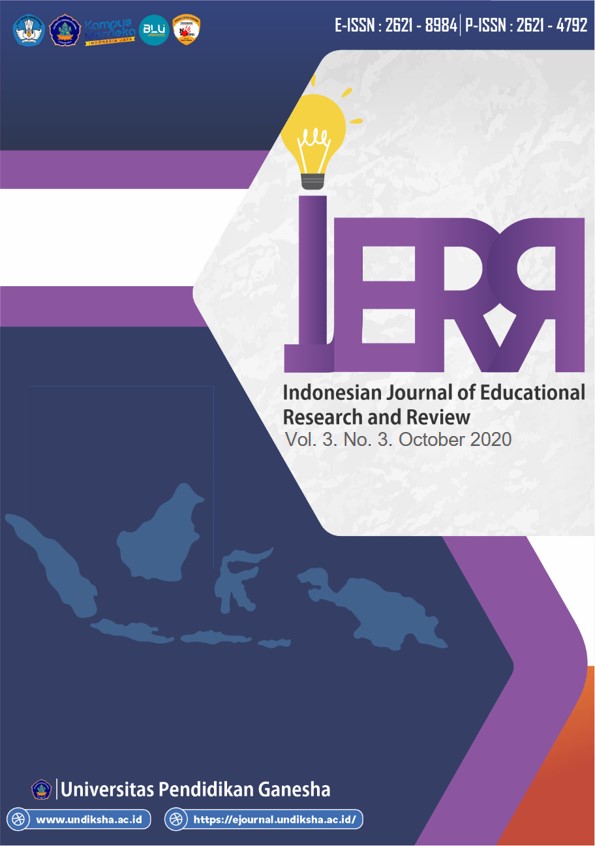The Earthquake Disaster Preparedness Instruments to Support Disaster Response Learning in Kindergartens
DOI:
https://doi.org/10.23887/ijerr.v3i3.30208Keywords:
Assessment, Preparedness, EarthquakeAbstract
This study aims to produce a valid and reliable assessment instruments for earthquake disaster preparedness in kindergarten for group B. This type of research is a research development (Research and Development) carried out using a procedural development model. In the instrument validation stage or the design validation, the assessment was carried out by two material experts. The instrument validation in this study was calculated using the Gregory formula. The product trial stage used 30 students, and the results were calculated using the Alpha Cronbach formula. This research results from the content validity test of 1.00, which is included in the very high category, and the validity test of the resulting items is nine useful items. Test the reliability of the instrument obtained results of 0.66, including high criteria. Therefore, it can be concluded that the instrument developed has been tested for its validity and reliability so that it can be used as an accurate learning assessment tool to measure the level of earthquake disaster preparedness in kindergarten in group B.
References
Akbar, E. (2015). Pembelajaran Siaga Bencana Anak Usia Dini (Vol. 25). Duta Media Publishing.
Antara, P. A. (2015). Pengembangan bakat seni anak pada taman kanak-kanak. Jurnal Ilmiah VISI, 10(1), 29-34. https://doi.org/10.21009/JIV.1001.4.
Antara, P. A. (2018). Stimulasi Metode Permainan Kreatif Berdesain Creative Movement Dan Budi Pekerti Dalam Mengembangkan Kemampuan Spasial Anak. Jurnal Pendidikan Usia Dini, 12(2), 301-310. https://doi.org/10.21009/JPUD.122.11.
Antara, P. A. (2019). Implementasi pengembangan karakter anak usia dini dengan pendekatan holistik. Jurnal Ilmiah Visi, 14(1), 17-26. https://doi.org/10.21009/JIV.1401.2.
Creswell, J. (2010). Pendekatan Kualitatif, Kuantitatif, dan Mixed. PT Pustaka Pelajar.
Dewi, R. S. (2019). Mitigasi Bencana Pada Anak Usia Dini. Early Childhood: Jurnal Pendidikan, 3(1), 68-77. http://umtas.ac.id/journal/index.php/EARLYCHILDHOOD/article/view/438.
Heri, H., & Caesar, R. (2018). Kesiapsiagaan Menghadapi Bencana Berbasis Sekolah. Jurnal Academia Praja, 1(02), 91-106. https://doi.org/10.36859/jap.v1i02.67.
Indriasari, F. N. (2018). Pengaruh pemberian metode simulasi siaga bencana gempa bumi terhadap kesiapsiagaan anak di Yogyakarta. Jurnal Keperawatan Soedirman, 11(3), 199-206. http://dx.doi.org/10.20884/1.jks.2016.11.3.700.
Izadkhah, Y. O., & Hossein, M. (2006). Earthquake disaster planning in nursery schools: Proceedings of the 8th US National Conference on Earthquake Engineering.Meilany. Bersahabat dengan Bencan Gempa Bumi. Mediantara Semesta PT.
Jannah, K., & Pahlevi, T. (2020). Pengembangan Instrumen Penilaian Berbasis Higher Order Thinking Skills Berbantuan Aplikasi" Kahoot!" Pada Kompetensi Dasar Menerapkan Penanganan Surat Masuk Dan Surat Keluar Jurusan OTKP Di SMK Negeri 2 Buduran. Jurnal Pendidikan Administrasi Perkantoran (JPAP), 8(1), 108-121. https://journal.unesa.ac.id/index.php/jpap/article/view/8172.
Ningtyas, D. P., & Risina, D. F. (2018). Pengembangan Permainan Sirkuit Mitigasi Bencana Gempa Bumi Untuk Meningkatkan Self Awareness Anak Usia Dini. Jurnal Caksana: Pendidikan Anak Usia Dini, 1(02). https://doi.org/10.31326/jcpaud.v1i02.198.
Noor, D. (2011). Geologi untuk Perencanaan. Graha Ilmu.
Nuraeni, N., Mujiburrahman, M., & Hariawan, R. (2020). Manajemen Mitigasi Bencana pada Satuan Pendidikan Anak Usia Dini untuk Pengurangan Risiko bencana Gempa Bumi dan Tsunami. Jurnal Penelitian dan Pengkajian Ilmu Pendidikan: e-Saintika, 4(1), 68-79. https://doi.org/10.36312/e-saintika.v4i1.200.
Pancaningrum, N. (2017). Strategi pembelajaran: Taksonomi bloom dalam games simulation method di tingkat raudhatul athfal. ThufuLA: Jurnal Inovasi Pendidikan Guru Raudhatul Athfal, 4(1), 112-129. http://dx.doi.org/10.21043/thufula.v4i1.1939.
Prasetya, T. I. (2012). Meningkatkan keterampilan menyusun instrumen hasil belajar berbasis modul interaktif bagi guru-guru IPA SMP N Kota Magelang. Journal of Research and Educational Research Evaluation, 1(2). https://journal.unnes.ac.id/sju/index.php/jere/article/view/873.
Putra, H. P. (2014). Pelatihan Mitigasi Bencana Kepadaanakanak Usia Dini. Asian Journal of Innovation and Entrepreneurship, 3(2), 115-119. https://journal.uii.ac.id/ajie/article/view/7817.
Rahma, A. (2018). Implementasi program pengurangan risiko bencana (PRB) melalui pendidikan formal. Jurnal VARIDIKA, 30(1), 1-11. http://journals.ums.ac.id/index.php/varidika/article/view/6537.
Salamah, U. (2018). Penjaminan Mutu Penilaian Pendidikan. EVALUASI: Jurnal Manajemen Pendidikan Islam, 2(1), 274-293. https://e-journal.staima-alhikam.ac.id/evaluasi/article/view/79.
Sari, D. P., & Suciana, F. (2019). Pengaruh edukasi audio visual dan role play terhadap perilaku siaga bencana pada anak sekolah dasar. Journal of Holistic Nursing Science, 6(2), 44-51. http://journal.ummgl.ac.id/index.php/nursing/article/view/2543.
Sugiyono. (2012). Metode Penelitian Pendidikan (Pendekatan Kuantitatif, Kualitatif dan R&D). Alfabeta.
Tirtayani, L. A., & Jampel, I. N. (2018, August). Materi siaga bencana pada kurikulum Pendidikan anak usia dini (PAUD) di Bali. In Prosiding Seminar Nasional dan Call For Paper Peranan Psikologi Bencana Dalam Mengurangi Risiko Bencana (pp. 186-199).
Utama, T. A., Delfina, R., & Saleha, N. (2019). Kesiapsiagaan Masyarakat dalam Menghadapi Bencana Gempa Bumi di Wilayah Lempuing. Jurnal Vokasi Keperawatan (JVK), 2(1), 1-8. https://doi.org/10.33369/jvk.v2i1.9122.
Utami, T. N., & Nanda, M. (2018). Pengaruh Pelatihan Bencana dan Keselamatan Kerja Terhadap Respons Persepsi Mahaiswa Prodi Ilmu Kesehatan Masyarakat. UIN Sumatera Utara.
Yusuf, M. (2015). Metode Penelitian Kuantitatif, Kualitatif, dan Penelitian Gabungan. Prenadamedia Group.
Downloads
Published
How to Cite
Issue
Section
License
Authors who publish with the Indonesian Journal of Educational Research and Review (IJERR) agree to the following terms:
- Authors retain copyright and grant the journal the right of first publication with the work simultaneously licensed under a Creative Commons Attribution-ShareAlike 4.0 International License. that allows others to share the work with an acknowledgment of the work's authorship and initial publication in this journal.
- Authors are able to enter into separate, additional contractual arrangements for the non-exclusive distribution of the journal's published version of the work (e.g., post it to an institutional repository or publish it in a book), with an acknowledgment of its initial publication in this journal.
- Authors are permitted and encouraged to post their work online (e.g., in institutional repositories or on their website) prior to and during the submission process, as it can lead to productive exchanges, as well as earlier and greater citation of published work. (See The Effect of Open Access)









